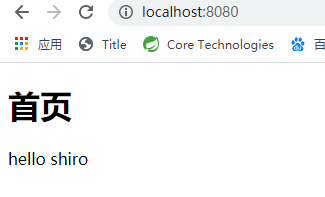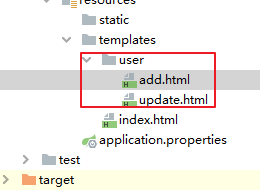1、准备工作
1 搭建一个SpringBoot项目、选中web模块即可!
2. 导入Maven依赖 thymeleaf
<dependency>
<groupId>org.springframework.boot</groupId>
<artifactId>spring-boot-starter-thymeleaf</artifactId>
</dependency>
3.编写一个页面 index.html templates下
<!DOCTYPE html>
<html lang="en"
xmlns:th="http://www.thymeleaf.org">
<head>
<meta charset="UTF-8">
<title>首页</title>
</head>
<body>
<h1>首页</h1>
<p th:text="${msg}"></p>
</body>
</html>
4.编写controller进行访问测试
package com.loey.controller;
import org.springframework.stereotype.Controller;
import org.springframework.ui.Model;
import org.springframework.web.bind.annotation.RequestMapping;
@Controller
public class MyController {
@RequestMapping({"/","/index"})
public String index(Model model){
model.addAttribute("msg","hello shiro");
return "index";
}
}
- 测试访问首页!

2、整合Shiro
回顾核心API:
- Subject:用户主体
- SecurityManager:安全管理器
- Realm:Shiro 连接数据
步骤:
1 导入Shiro 和 spring整合的依赖
<dependency>
<groupId>org.apache.shiro</groupId>
<artifactId>shiro-spring</artifactId>
<version>1.7.0</version>
</dependency>
2.编写Shiro 配置类 config包
package com.loey.config;
import org.springframework.context.annotation.Configuration;
//声明为配置类
@Configuration
public class ShiroConfig {
//创建 ShiroFilterFactoryBean
//创建 DefaultWebSecurityManager
//创建 realm 对象
}
3.我们倒着来,先想办法创建一个 realm 对象
4.我们需要自定义一个 realm 的类,用来编写一些查询的方法,或者认证与授权的逻辑
package com.loey.config;
//自定义Realm
public class UserRealm extends AuthorizingRealm{
//执行授权逻辑
@Override
protected AuthorizationInfo doGetAuthorizationInfo(PrincipalCollection principals) {
System.out.println("执行了=>授权逻辑PrincipalCollection");
return null;
}
//执行认证逻辑
@Override
protected AuthenticationInfo doGetAuthenticationInfo(AuthenticationToken token) throws AuthenticationException {
System.out.println("执行了=>认证逻辑AuthenticationToken");
return null;
}
}
5 将这个类注册到我们的Bean中! ShiroConfig
//创建 realm 对象
@Bean
public UserRealm userRealm(){
return new UserRealm();
}
- 接下来我们该去创建 DefaultWebSecurityManager 了
//创建 DefaultWebSecurityManager
@Bean(name = "securityManager")
public DefaultWebSecurityManager getDefaultWebSecurityManager(@Qualifier("userRealm") UserRealm userRealm){
DefaultWebSecurityManager securityManager = new DefaultWebSecurityManager();
//关联Realm
securityManager.setRealm(userRealm);
return securityManager;
}
7.接下来我们该去创建 ShiroFilterFactoryBean 了
//创建 ShiroFilterFactoryBean
@Bean
public ShiroFilterFactoryBean getShiroFilterFactoryBean(@Qualifier("securityManager") DefaultWebSecurityManager securityManager){
ShiroFilterFactoryBean shiroFilterFactoryBean = new ShiroFilterFactoryBean();
//设置安全管理器
shiroFilterFactoryBean.setSecurityManager(securityManager);
return shiroFilterFactoryBean;
}
最后上完整的配置:
package com.loey.config;
import org.apache.shiro.spring.web.ShiroFilterFactoryBean;
import org.apache.shiro.web.mgt.DefaultWebSecurityManager;
import org.springframework.beans.factory.annotation.Qualifier;
import org.springframework.context.annotation.Bean;
import org.springframework.context.annotation.Configuration;
//声明为配置类
@Configuration
public class ShiroConfig {
//创建 ShiroFilterFactoryBean
@Bean
public ShiroFilterFactoryBean getShiroFilterFactoryBean(@Qualifier("securityManager") DefaultWebSecurityManager securityManager){
ShiroFilterFactoryBean shiroFilterFactoryBean = new ShiroFilterFactoryBean();
//设置安全管理器
shiroFilterFactoryBean.setSecurityManager(securityManager);
return shiroFilterFactoryBean;
}
//创建 DefaultWebSecurityManager
@Bean(name = "securityManager")
public DefaultWebSecurityManager getDefaultWebSecurityManager(@Qualifier("userRealm") UserRealm userRealm){
DefaultWebSecurityManager securityManager = new DefaultWebSecurityManager();
//关联Realm
securityManager.setRealm(userRealm);
return securityManager;
}
//创建 realm 对象
@Bean
public UserRealm userRealm(){
return new UserRealm();
}
}
3、页面拦截实现
1.编写两个页面、在templates目录下新建一个 user 目录 add.html update.html

add.html
<!DOCTYPE html>
<html lang="en">
<head>
<meta charset="UTF-8">
<title>add</title>
</head>
<body>
<h1>add</h1>
</body>
</html>
update.html
<!DOCTYPE html>
<html lang="en">
<head>
<meta charset="UTF-8">
<title>update</title>
</head>
<body>
<h1>update</h1>
</body>
</html>
2.编写跳转到页面的controller
@RequestMapping("/user/add")
public String add(){
return "user/add";
}
@RequestMapping("/user/update")
public String update(){
return "user/update";
}
3.在index页面上,增加跳转链接
<!DOCTYPE html>
<html lang="en"
xmlns:th="http://www.thymeleaf.org">
<head>
<meta charset="UTF-8">
<title>首页</title>
</head>
<body>
<h1>首页</h1>
<p th:text="${msg}"></p>
<a th:href="@{/user/add}">add</a>
<a th:href="@{/user/update}">update</a>
</body>
</html>
4.测试页面跳转是否OK

5.准备添加Shiro的内置过滤器
//创建 ShiroFilterFactoryBean
@Bean
public ShiroFilterFactoryBean getShiroFilterFactoryBean(@Qualifier("securityManager") DefaultWebSecurityManager securityManager){
ShiroFilterFactoryBean shiroFilterFactoryBean = new ShiroFilterFactoryBean();
//设置安全管理器
shiroFilterFactoryBean.setSecurityManager(securityManager);
Map<String, String> filterMap = new LinkedHashMap<String,String>();
/*
添加Shiro内置过滤器,常用的有如下过滤器:
anon: 无需认证就可以访问
authc: 必须认证才可以访问
user: 如果使用了记住我功能就可以直接访问
perms: 拥有某个资源权限才可以访问
role: 拥有某个角色权限才可以访问
*/
filterMap.put("/user/add","authc");
filterMap.put("/user/update","authc");
shiroFilterFactoryBean.setFilterChainDefinitionMap(filterMap);
return shiroFilterFactoryBean;
}
6.再起启动测试,访问链接进行测试!拦截OK!但是发现,点击后会跳转到一个404页面,这 个不是我们想要的效果,我们需要自己定义一个Login页面!
7.我们编写一个自己的Login页面
<!DOCTYPE html>
<html lang="en"
xmlns:th="http://www.thymeleaf.org">
<head>
<meta charset="UTF-8">
<title>登录页</title>
</head>
<body>
<div style="margin-left:auto; margin-right:auto;width:200px;height:100px;">
<form th:action="@{/login}">
<h1 style="text-align:center">登录</h1><br/>
用户名:<input type="text" name="username"><br/>
密码: <input type="password" name="password"><br/>
<input type="submit" value="登录"><br/>
</form>
</div>
</body>
</html>
8.编写跳转的controller
@RequestMapping("/toLogin")
public String toLogin(){
return "login";
}
9.在shiro中配置一下! ShiroFilterFactoryBean() 方法下面
//修改要跳转的login页面
shiroFilterFactoryBean.setLoginUrl("/toLogin");
10.再次测试,成功的跳转到了我们指定的Login页面!

11.优化一下代码,我们这里的拦截可以使用 通配符来操作
// filterMap.put("/user/add","authc");
// filterMap.put("/user/update","authc");
filterMap.put("/user/*","authc");
shiroFilterFactoryBean.setFilterChainDefinitionMap(filterMap);
4、登录认证操作
1.编写一个登录的controller
//登录操作
@RequestMapping("/login")
public String login(String username,String password,Model model){
//使用shiro编写认证操作
//1.获取Subject(当前用户)
Subject subject = SecurityUtils.getSubject();
//2.封装用户的数据
UsernamePasswordToken token = new UsernamePasswordToken(username, password);
//3.执行登录的方法,只要没有异常就代表登录成功
try {
subject.login(token);
return "index";
}catch (UnknownAccountException uae) {//如果没有指定的用户,则 UnknownAccountException异常
model.addAttribute("msg","用户名不存在");
return "login";
} catch (IncorrectCredentialsException ice) {//密码不对的异常
model.addAttribute("msg","密码错误");
return "login";
}
}
2.在前端修改对应的信息输出或者请求! 登录页面增加一个 msg 提示
登录页面增加一个 msg 提示
<p style="color:red;" th:text="${msg}"></p>
给表单增加一个提交地址
<form th:action="@{/login}">
- 理论,假设我们提交了表单,他会经过我们刚才编写的UserRealm,我们提交测试一下

确实执行了我们的认证逻辑!
4.在 UserRealm 中编写用户认证的判断逻辑
package com.loey.config;
import org.apache.shiro.authc.*;
import org.apache.shiro.authz.AuthorizationInfo;
import org.apache.shiro.realm.AuthorizingRealm;
import org.apache.shiro.subject.PrincipalCollection;
//自定义Realm
public class UserRealm extends AuthorizingRealm {
//执行授权逻辑
@Override
protected AuthorizationInfo doGetAuthorizationInfo(PrincipalCollection principals) {
System.out.println("执行了=>授权逻辑PrincipalCollection");
return null;
}
//执行认证逻辑
@Override
protected AuthenticationInfo doGetAuthenticationInfo(AuthenticationToken token) throws AuthenticationException {
System.out.println("执行了=>认证逻辑AuthenticationToken");
//假设数据库的用户名和密码
String name = "root";
String password = "111";
//1.判断用户名
UsernamePasswordToken userToken = (UsernamePasswordToken) token;
if(!userToken.getUsername().equals(name)){
//用户名不存在
return null;//shiro底层会抛出 UnknownAccountException
}
//2. 验证密码,我们可以使用一个AuthenticationInfo实现类 SimpleAuthenticationInfo
// shiro会自动帮我们验证!重点是第二个参数就是要验证的密码
return new SimpleAuthenticationInfo("",password,"");
}
}
5、完整的pom.xml
<?xml version="1.0" encoding="UTF-8"?>
<project xmlns="http://maven.apache.org/POM/4.0.0" xmlns:xsi="http://www.w3.org/2001/XMLSchema-instance"
xsi:schemaLocation="http://maven.apache.org/POM/4.0.0 https://maven.apache.org/xsd/maven-4.0.0.xsd">
<modelVersion>4.0.0</modelVersion>
<parent>
<groupId>org.springframework.boot</groupId>
<artifactId>spring-boot-starter-parent</artifactId>
<version>2.4.2</version>
<relativePath/> <!-- lookup parent from repository -->
</parent>
<groupId>com.loey</groupId>
<artifactId>shiro-02-springboot</artifactId>
<version>0.0.1-SNAPSHOT</version>
<name>shiro-02-springboot</name>
<description>Demo project for Spring Boot</description>
<properties>
<java.version>11</java.version>
</properties>
<dependencies>
<dependency>
<groupId>org.apache.shiro</groupId>
<artifactId>shiro-spring</artifactId>
<version>1.7.0</version>
</dependency>
<dependency>
<groupId>org.springframework.boot</groupId>
<artifactId>spring-boot-starter-thymeleaf</artifactId>
</dependency>
<dependency>
<groupId>org.springframework.boot</groupId>
<artifactId>spring-boot-starter-web</artifactId>
</dependency>
<dependency>
<groupId>org.springframework.boot</groupId>
<artifactId>spring-boot-starter-test</artifactId>
<scope>test</scope>
</dependency>
</dependencies>
<build>
<plugins>
<plugin>
<groupId>org.springframework.boot</groupId>
<artifactId>spring-boot-maven-plugin</artifactId>
</plugin>
</plugins>
</build>
</project>
























 666
666











 被折叠的 条评论
为什么被折叠?
被折叠的 条评论
为什么被折叠?








